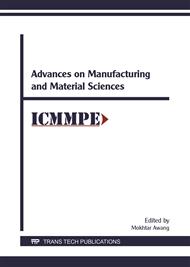p.86
p.93
p.100
p.111
p.118
p.125
p.133
p.139
p.145
Machinability Study of Hybrid FRP Composite Using Abrasive Waterjet Trimming Technology
Abstract:
Machining of fiber reinforcement polymer (FRP) composite without any defect is extremely challenging when using conventional processes. This mainly due to its inherent anisotropic, heterogeneous, thermal sensitivity, and highly abrasive of nature of fiber reinforcement. Therefore, a kind of non-conventional machining process namely abrasive waterjet machining (AWJM) was endeavoured as it has been reported to be able to machine or cut almost any material included composites. In fact, previous research only provides partially desired parameters on machining these materials and mainly focuses on plain FRP composite. Therefore, this research attempted to evaluate the significant AWJM process parameters comprehensively on the main machinability output on the hybrid FRP composite. 2k factorial design and statistical analysis of variance (ANOVA) were applied to determine the performance of trimming process regarding surface roughness and delamination (entrance and exit). Experimental results revealed that the surface roughness was affected by the stand-off distance, abrasive flow rate, traverse rate rather than hydraulic pressure. Similar findings as to that of surface roughness were also observed for the top and bottom delamination damage.
Info:
Periodical:
Pages:
118-124
Citation:
Online since:
June 2017
Authors:
Price:
Сopyright:
© 2017 Trans Tech Publications Ltd. All Rights Reserved
Share:
Citation:


